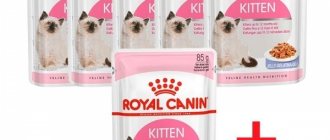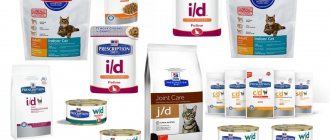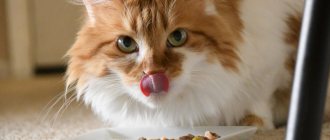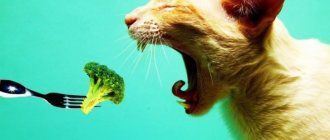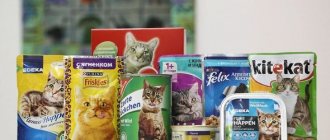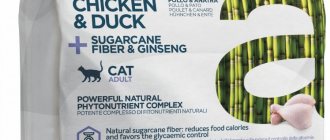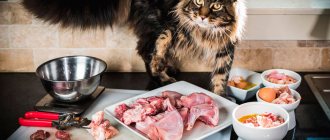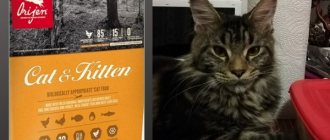Key points in feeding kittens
The main question: is it possible to feed a kitten dry food? You can make it the main dish of your baby’s menu from the age of two months, without mixing it with natural products, avoiding unnecessary stress on the digestive organs.
How much to give daily?
- For a kitten of three to six months, it is recommended to pour 50 - 110 grams, feed 4 times;
- a six-month-old baby will need 200 - 250 grams (period of intensive growth), feed 2 - 3 times;
- 200 grams is enough for a one-year-old fluffy.
Focus on the composition of the product. High-quality dry cat food is balanced, contains the necessary vitamins and minerals, and ensures proper development. If you give vitamin supplements unnecessarily (unless prescribed by a veterinarian), you risk provoking the development of the disease.
Take care of the feeding area; ideally it is:
- quiet, without the presence of strangers (if there are a lot of pets, make sure you have an individual bowl);
- clean.
An important point is to ensure access to clean drinking water: dry food does not contain liquid, drinking will help the kitten avoid dehydration.
Compound
In most diets, the first place in the composition of diets is the plant component (wheat, vegetable proteins, rice). Only then follows hydrolyzed (dried) animal protein of a specific type. Some diets contain flour from grain crops (which ones are not specified). The composition also contains technical additives - antioxidants and preservatives. The feed contains vitamin and mineral components.
The main ingredients in Royal Canin wet food are meat and offal. Cereals, plant components and sources of carbohydrates are also present.
Nutrition of adults
Daily feeding standards for dry food involve feeding adult cats twice a day. Some owners allow their pets to eat more often. However, an obese animal should not be allowed unimpeded access. Remember: excess weight provokes serious disruptions in the functioning of the body, leading to diseases of the thyroid gland and hypothalamus. On average, a mature individual requires 80-120 grams. daily.
As for cats, 180-210 kcal is enough for them. The formula will help you calculate the amount of dry food: 30 - 60 kcal multiplied by weight. So, an adult cat weighing 5 kilograms needs 150 - 300 grams daily.
Sometimes cats refuse to eat for a long time. The situation can be misleading; the owner’s first thought is: “I’m sick.” Refusal to eat for more than 48 hours indicates not only illness, but also stress, for example, moving to a new place of residence. A dirty bowl and bad-smelling food are common reasons for refusing to eat. Keep the bowl and area clean.
The characteristics of the breed impose restrictions on the daily amount of food. Maine Coon, Norwegian Forest, Cornish Rex are naturally prone to gaining excess body weight. It makes sense to switch purebred pets to a special low-calorie food. A cat’s daily diet depends on several factors: health status, breed characteristics, lifestyle.
Nutrition standards for cats after castration and sterilization
Pets that have undergone castration and sterilization experience a period of reduced activity, eat less, and their sleep time increases. Animals should be fed special low-fat food. Buy toys from a pet store and involve them in games, encouraging the cat to move more. It is recommended to feed 2-3 times, in small portions. The usual daily diet for cats after surgery is 150 - 200 grams of dry food. Watch your weight: he quickly gains kilograms - reduce the dose of food to 130 grams.
A dangerous consequence of castration (sterilization) is urolithiasis. You can avoid the disease by simply not feeding fish or foods rich in phosphorus and magnesium.
Feeding a cat dry food containing vitamins, minerals, and natural meat is the key to a beautiful, smooth coat, healthy teeth, and active pet. Food is divided by age; food for a kitten is very different from food for an older cat in terms of calorie content. Special food suitable for sterilized cats is not uncommon: Hills, Eukanuba, Royal Canin produce a high-quality product that meets all requirements. You can find food and get detailed advice in the Zoomix store.
Conclusions about Royal Canin food
There are both positive and negative reviews about Royal Canin cat food. Although there are much more of the former than the latter, the composition of the feed as a whole can be called complete. In principle, such food can be used as a permanent diet.
It should be noted that there are super-premium foods, for example, Czech-made Brit Care or Italian-made Monge, the price of which is not much different from Royal Canin. However, they are much less common and often it will be difficult to buy them.
- Mars
- Premium food for cats
Feeding pregnant cats
The nutritional standards for cats in this situation differ in composition. During the period of gestation, it is important for the animal to receive all the vitamins and microelements for the harmonious intrauterine development of the cubs. It would be a good idea to consult a veterinarian if your pet needs to adjust its diet. The main thing is that without zealous initiative, the correct advice will be given by an experienced specialist.
The correct composition of food for a pregnant cat
The diet of a cat expecting offspring is considered balanced if it is rich in proteins, minerals, and vitamins:
- calcium is considered the main vitamin for healthy teeth and bones; calcium is responsible for lactation;
- Vitamin A ensures visual acuity and gives cats smooth, well-groomed fur;
- Animal protein is the basis for the harmonious development of kittens in utero and is important for the health of the pregnant mother.
- without vitamin E, regeneration is impossible; the vitamin ensures the health of the reproductive system;
- blood clotting is the work of vitamin K, which is especially important during childbirth.
- Fiber can improve intestinal activity.
How to feed a pregnant pet?
An important rule during the period of gestation of kittens is not to change the mother’s type of nutrition, feed her usual food. At about 2 weeks of pregnancy, the cat begins to eat 10% more; from day 21 the daily norm doubles. At the end of the gestation period, cats may refuse to eat; veterinarians consider refusal to be a harbinger of childbirth.
Experts have not found a common approach to the question of how many times to feed a pet that is in an interesting position. Owners choose different ways: they pamper with free access to food, while others feed on demand. The main thing is that the cat treat provides the pregnant cat with the necessary nutrients, helps the kittens develop for eight weeks, ensures lactation, a healthy appearance, and the increased calorie needs of the new mother. When choosing dry food, make sure that the composition has a list of what is necessary, without harmful chemical additives.
What food is suitable for a nursing cat?
Kitten food is equally suitable for a nursing cat. We recommend choosing Iams kitten, Pro plan kitten, Baby cat from Royal Canin. The food has a nutritional composition, does not have harmful flavoring additives, and covers the daily calorie requirement.
Composition of Royal Canin Gastro Intestinal
Eating dietary food by a cat throughout its life is the key to health for a pet with digestive tract problems. The basis of the product includes:
- pork and poultry;
- poultry liver;
- corn flour;
- omega-3;
- various minerals;
- taurine;
- healthy sugars;
- yeast hydrolyzate;
- cellulose;
- marigold extract;
- various vitamins and microelements.
Dry pet food contains various nutritional supplements, per 100 g of product: 7.6 g of protein, 0.57 g of dietary fiber, 5.6 g of fat, 4.63 g of carbohydrates, etc. The metabolic energy of the product is only 93 kcal per 100 g of feed and 465.5 kcal per 100 g of dry matter. Elements such as vitamin D3, iron, iodine, zinc are useful for a pet after an illness.
Nutrition for older cats
The norms for feeding dry food to older vary significantly. This is due to a decrease in the activity of animals (sleep time increases, periods of activity decrease, fewer calories are consumed). Much attention is paid to nutrition: food affects the health and quality of life of an elderly family pet. The choice should be made on special foods that are rich in protein and low in carbohydrates, which increase the risk of obesity.
Daily nutritional requirements for elderly pets
The daily serving of cat treats depends on the brand of dry food. Normally, it is 5-7% of body weight. However, the cat will need more food if the owner purchases economy-class food, since the composition of the food differs in the content of cellulose, animal waste, and is low in calories.
High-quality food is more expensive, but has the advantage that you can give your pet small portions. Food containing vitamins and animal fats helps support the immune, urinary, and cardiovascular systems of an elderly cat. He advises you to pay attention to the following brands of food: Purina, Royal Canin, 1st choice.
Composition of regular, therapeutic and prophylactic feed
Premium, super-premium, extra-class food presented by Royal Canin have a completely balanced composition. The basis of dry food is dehydrated protein from beef, fish, poultry, and rabbit. The composition includes animal fats, plant fiber, yeast, amino acids, vitamins, minerals (magnesium, potassium, iodine, selenium, calcium), useful organic compounds, biologically active substances.
Therapeutic feeds may contain prebiotics, probiotics, lutein, taurine, folic acid, vitamins B1, B3, B6, B9, B12, C, A, E, PP.
In the veterinary line of food (hepatic, hypoallergenic, intestinal, renal, urinary, royal farm), the composition may not include some components. So, for example, Royal Canin Urinary S/O, which is prescribed for the prevention of urolithiasis in cats, contains special additives that prevent the formation of stones in the bladder and kidneys.
Royal Canin Urinari
Is proper nutrition a prerequisite?
Breeders and experienced owners know: the standards described on the packaging give average recommendations. Observation will help determine whether the cat is healthy. An animal eats more than usual and does not gain weight well, which is a reason to change its diet. Feed with low nutrient content does not meet daily requirements. When choosing a different diet, make the transition gradually so as not to expose your pet to stress. It is better to seek the help of an experienced veterinarian who can help with the issue.
Cats often neglect new food. So, accustomed to food from cheap brands, fluffies will turn away from a bowl of premium food. The behavior is related to the composition of the menu: it is as close to natural as possible. Cheap granules contain artificial additives and flavoring agents that are addictive, so your pet will refuse to eat “tasteless” expensive food.
In the case of selecting dry food, the instructions vary. However, try to choose foods that have a good balance. The healthy appearance of a pet, good strong teeth, shiny fur, activity, and curiosity depend entirely on the diet. Try to adhere to the feeding rates indicated on the package. The measure will help avoid obesity and metabolic problems.
The correct dosage is important for pussies with chronic diseases. Entrust the selection of a good diet to your veterinarian, and always follow the instructions. It is more convenient to pour the granules into a special measuring cup indicating the dosage. You can buy a glass at a pet store.
Do you need to buy high-quality, tasty, healthy cat food? The Zoomix store will help you choose the best option! Let's make our furry family members happy together!
Indications for use
Royal Canin Gastro Intestinal food for cats with impaired digestive system is recommended for consumption in the following cases:
- moderate to severe intestinal disorder;
- chronic inflammation of the gastrointestinal tract;
- problems with digestion of food and absorption of beneficial components;
- bacterial overgrowth in the small intestine;
- colitis and gastritis;
- various liver problems other than encephalopathy;
- rehabilitation period after any illness;
- if the cat is underweight.
